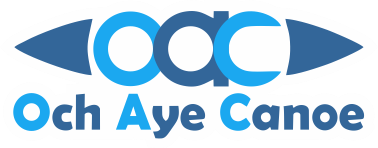
Och Aye Canoe provides a buoyancy aid for you to wear during all their water based activities, however maybe you're starting to get into the hobby now and would like to start buying some of your own kit? Your own buoyancy aid can be a good place to start, but with so many on the market how do you decide what's right for you?
In this blog I'm going to let you know about some of the different ones, hopefully this will help you with your decision.
Do I need a buoyancy aid or a lifejacket? What's the difference?
A buoyancy aid, sometimes also called a personal floatation device (PFD), is as the name suggests a floatation. This means it will help you to float whilst swimming. However in a rare case of you being unconscious facing down in the water whilst wearing one you will remain facing down.
Here is a typical looking buoyancy aid:-

A lifejacket inflates usually by pulling a cord (some have automatic inflation on contact with water), these are generally worn for watersports where you are unlikely to end up in the water e.g. Powerboating, large yachts, etc.
In the rare case of you being unconscious face down in the water a lifejacket has extra buoyancy around the neck area and will turn your head around to face upwards. Some people like young children to wear lifejackets instead of buoyancy aids for this reason.
Here is a typical looking life jacket:-

By law buoyancy aids must be certified that they offer a minimum amount of buoyancy, which is measured in Newtons.
A buoyancy aid / PFD will normally be around 45-50N, a lifejacket normally around 150-165N. You should check your weight against the Newtons to ensure you have sufficient buoyancy.
Buoyancy Aid Types
Recreational
Suitable for most water activities, such as kayaking and paddleboarding. These buoyancy aids have few features but are fully adjustable and comfortable to wear. Some will also include a pocket.

This type of buoyancy aid will generally have adjustable shoulder straps, a front zip, an adjustable waist strap, and perhaps adjustable side straps.
White Water
Suitable for any moving water but can also be used in most other water environments. They usually have at least one pocket and will be more adjustable and secure on your body. They tend to be a bit more cut away at the arms allowing easier movement when paddling.

This type of buoyancy aid will generally have adjustable shoulder straps, front pockets, adjustable side straps, front pocket, accessory pockets, accessory clip.
Touring
Suitable for most water environments but designed for touring and expeditions. Will have at least one pocket on the front and usually a large pocket on the back to take a hydration system. Extra features may include high visibility strips.

This type of buoyancy aid will generally have adjustable shoulder straps, accessory clip, front pocket, front zip, adjustable waist and side straps, fluorescent strips.
Adjustability and Comfort
Most of the models will have adjustment, usually by way of webbing and buckles around the waist. You want to make sure the buoyancy aid is secure enough that it cannot lift up and over your head if you were to fall in. Some children's buoyancy aids have leg loops to help prevent this from happening.
Remember to have enough adjustment to be comfortable regardless of which clothing you have on underneath.
Extra features
Some models of buoyancy aids will have additional features which as a quick release harness, etc.
Still unsure?
If you're unsure please contact me and I'll do my best to help you out and you can also try some of the different styles of buoyancy aids I have. And remember Och Aye Canoe may be able to order the buoyancy aid you're after so just ask!


